
All images in this post are by the great Ben Champoux. Huge thanks to him for letting me use them!
The Black Box Challenge
Up before the sun, the chefs and judges climbed aboard a coach at 7:25 a.m.to return to Algonquin College for the Black Box event. Our guests arrived a little later, settling in to the space where the College has created its International Restaurant. Algonquin’s culinary students prepared a spectacular buffet breakfast, complete with omelette station, and everyone was able to watch the chefs cook on enormous closed-circuit tv screens. Two experts provided a very entertaining running commentary – Robert Beauchemin, who was our Montreal Senior Judge for many years and knows the competition backwards, and Mat Beausoleil, one of Ottawa’s most popular celebrity cooks and food bloggers. As soon as the chefs and sous chefs had been introduced, deprived of their cellphones and smart watches and sent away to their sensory-deprivation holding pen, we showed the guests what their black box contained this year – seven ingredients that each chef must include in the dish they made for the judges. They also had a generous pantry at hand.
This year the box contained the following seven surprises: a kilo of elk generously donated by Elk Ranch, a local farm near Kanata, within Ottawa’s city limits; the cut was eye of round, a muscle that looks like a tapering loin but is a fair bit tougher, setting an extra challenge for the chefs. A small amount (3.75 grams) of dried and powdered phytoplankton donated by Bluegenics Innovations Inc from Sackville, New Brunswick, an intensely flavourful item that smelt and tasted very like a kelp-filled rock pool at low tide and looked like macha tea. A bag of organic rolled oats donated by La Minoterie des Anciens in Gaspesie. A number (around 18) of pickled fiddleheads (ostrich ferns), foraged wild by Forbes Wild Foods and lightly pickled to preserve them; still firm, they tasted mildly of caperberries – and our thanks to Jonathan Forbes for donating them. One and a half cups of haskap berries, once frozen now thawed, donated by Doris and Axel Hvidberg of High Mountain Farm in Salmon Arm, BC; haskaps look like elongated blueberries but are more closely related to honeysuckle and elder; they taste like an intense and tart-sweet cross between blueberries, raspberries and blackberries. To round things off, we included a big bunch of black kale and two kilos of parsley root.
The Black Box is all about improvisation and creativity; chefs who think outside the box and present us with imaginative rather than obvious solutions score higher. I hoped the ingredients would challenge them and that our competitors would appreciate the enormous difference in ages between the things in the box – phytoplankton (200 million years), fiddlehead ferns (a plant that has remained unchanged for 180 million years), elk (hailing from Pleistocene Beringia about 70,000 years ago), oats (the oldest known cultivated oat remains were found in caves in Switzerland that date back to around 1,000 BC), parsley root (the modern parsley root, Petroselinum crispum, was first mentioned in a Dutch cookbook written in the second half of the 15th century), black kale (this cultivar, also known as dinosaur kale, was first cultivated by gardeners in Italy in the 17th century), and finally haskap berries (though native to Canada, Japan and Russia, this variety was developed three years ago at the University of Saskatchewan).
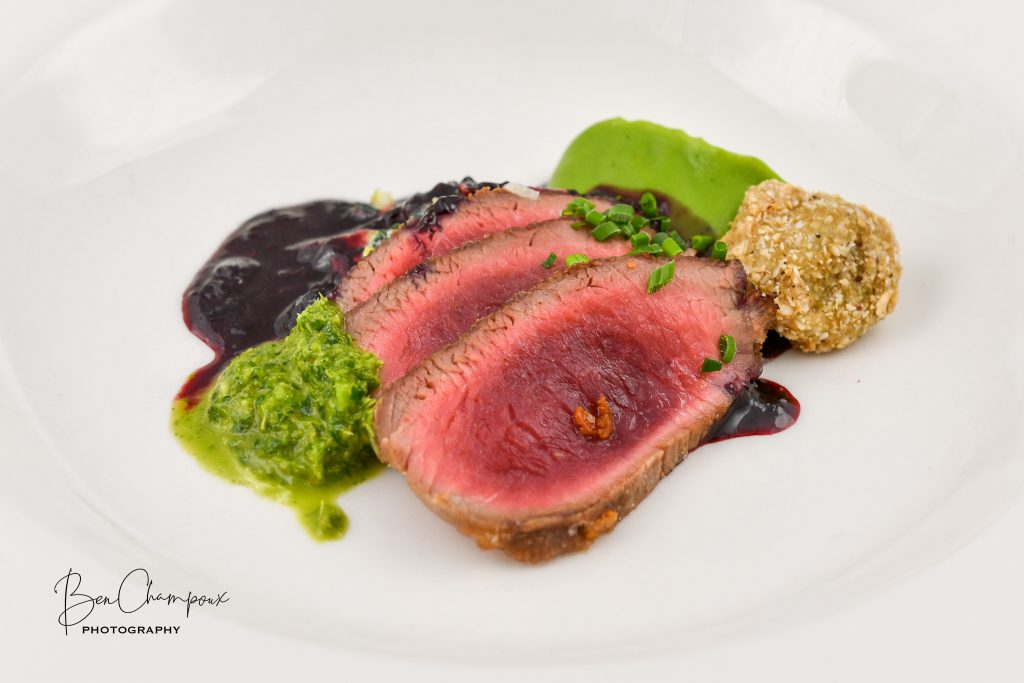 Fortified by coffee and pastries, the judges waited in their tasting room for the first dish to appear. It came from Matt Pennell (Moncton). He had seared the elk in butter then cut it into steaks that showed a lovely gradation from rare to medium and proved more tender than the judges had feared. He poached the kale in cream, spiked with cheese (so yummy) and coated the fiddleheads in well-seasoned flour ground from the oatmeal before frying them to crispness. The parsley root became a rich purée, dyed green and flavoured by the plankton powder. Chef also made a nicely textured gremolata of the parsley tops, sharpened with citrus. The haskap berries were turned into a tangy compote of a sauce.
Fortified by coffee and pastries, the judges waited in their tasting room for the first dish to appear. It came from Matt Pennell (Moncton). He had seared the elk in butter then cut it into steaks that showed a lovely gradation from rare to medium and proved more tender than the judges had feared. He poached the kale in cream, spiked with cheese (so yummy) and coated the fiddleheads in well-seasoned flour ground from the oatmeal before frying them to crispness. The parsley root became a rich purée, dyed green and flavoured by the plankton powder. Chef also made a nicely textured gremolata of the parsley tops, sharpened with citrus. The haskap berries were turned into a tangy compote of a sauce.
 Chef Jenny M. Kang (Calgary) came next. She made elk tataki, searing it briefly with salt, pepper and balsamic, then slicing it very thinly. Inside its lightly caramelized edge, the meat was basically raw, very juicy and tender. Chef used the plankton in lieu of bonito in a tangy ponzu sauce with soy and lemon from the pantry. Kale became crisp little chips and so did the parley root (I could have eaten a bag of them), while Chef chopped the fiddleheads into a salsa mixed with tomato brunoise, lime, lemon and vinegar – lovely and sharp but ther taste of the fiddleheads still shone through. Toasting the oatmeal with sugar added a welcome sweetness to balance the acidity of the dish and Chef Kang scattered a little judiciously around the plate. A teaspoonful of haskap compote worked as a sweet-sour condiment with the meat. Such a dainty-looking dish; such big flavours!
Chef Jenny M. Kang (Calgary) came next. She made elk tataki, searing it briefly with salt, pepper and balsamic, then slicing it very thinly. Inside its lightly caramelized edge, the meat was basically raw, very juicy and tender. Chef used the plankton in lieu of bonito in a tangy ponzu sauce with soy and lemon from the pantry. Kale became crisp little chips and so did the parley root (I could have eaten a bag of them), while Chef chopped the fiddleheads into a salsa mixed with tomato brunoise, lime, lemon and vinegar – lovely and sharp but ther taste of the fiddleheads still shone through. Toasting the oatmeal with sugar added a welcome sweetness to balance the acidity of the dish and Chef Kang scattered a little judiciously around the plate. A teaspoonful of haskap compote worked as a sweet-sour condiment with the meat. Such a dainty-looking dish; such big flavours!
 Chef Ian Carswell (Ottawa-Gatineau) was our third competitor. By now we were getting used to the exquisite way he presents his food; this time he also took pains to use many of the ingredients in more than one way, much to the judges’ approval. He turned the elk into miniature schnitzel breaded with a toasted oatmeal crust; the meat was a bit chewy but no more so than many schnitzels I have been served in a restaurant. Chef decided to combine the kale, the chopped fiddleheads and the plankton powder into a warm salad, spiked with pepper and finely crumbled pancetta. Then he used the plankton again in a parsley root chantilly as light as whipped cream (schnitzel mit Schlag – how Viennese!). He turned the haskaps into a purée and used it to draw his ‘S’-and-three-dots emblem on the plate. An artist should sign his work.
Chef Ian Carswell (Ottawa-Gatineau) was our third competitor. By now we were getting used to the exquisite way he presents his food; this time he also took pains to use many of the ingredients in more than one way, much to the judges’ approval. He turned the elk into miniature schnitzel breaded with a toasted oatmeal crust; the meat was a bit chewy but no more so than many schnitzels I have been served in a restaurant. Chef decided to combine the kale, the chopped fiddleheads and the plankton powder into a warm salad, spiked with pepper and finely crumbled pancetta. Then he used the plankton again in a parsley root chantilly as light as whipped cream (schnitzel mit Schlag – how Viennese!). He turned the haskaps into a purée and used it to draw his ‘S’-and-three-dots emblem on the plate. An artist should sign his work.
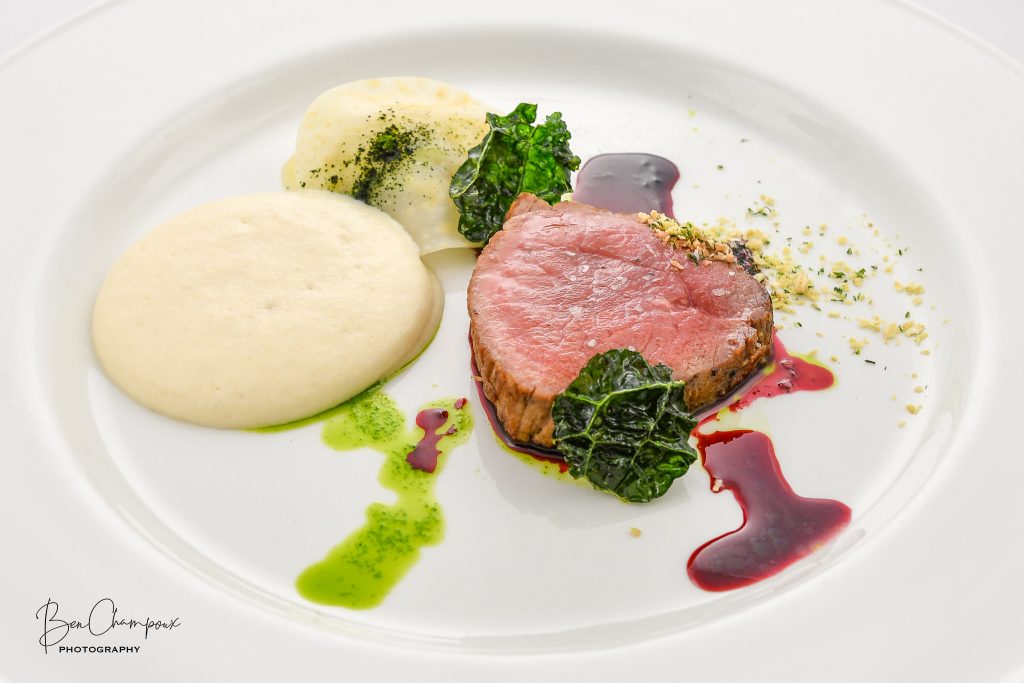 Up fourth was Chef Kai Koroll (Kelowna). He pan-seared the elk and cut it into thick, flavourful steaks that had the perfectly acceptable tenderness of a flank steak (a fine testament to the quality of the meat from Elk Ranch!). He cooked down the chopped fiddleheads, a little of the plankton and a great deal of leek and used it to fill a single raviolo made not with pasta but with a paper-thin sheet of celeriac; more plankton dusted its surface. The parsley root became a foam, enriched with parmesan, while the oatmeal appeared as herbed crumbs spooned over the edge of the elk steak. Haskap gastrique and a green oil made with the parsley tops were finishing touches.
Up fourth was Chef Kai Koroll (Kelowna). He pan-seared the elk and cut it into thick, flavourful steaks that had the perfectly acceptable tenderness of a flank steak (a fine testament to the quality of the meat from Elk Ranch!). He cooked down the chopped fiddleheads, a little of the plankton and a great deal of leek and used it to fill a single raviolo made not with pasta but with a paper-thin sheet of celeriac; more plankton dusted its surface. The parsley root became a foam, enriched with parmesan, while the oatmeal appeared as herbed crumbs spooned over the edge of the elk steak. Haskap gastrique and a green oil made with the parsley tops were finishing touches.
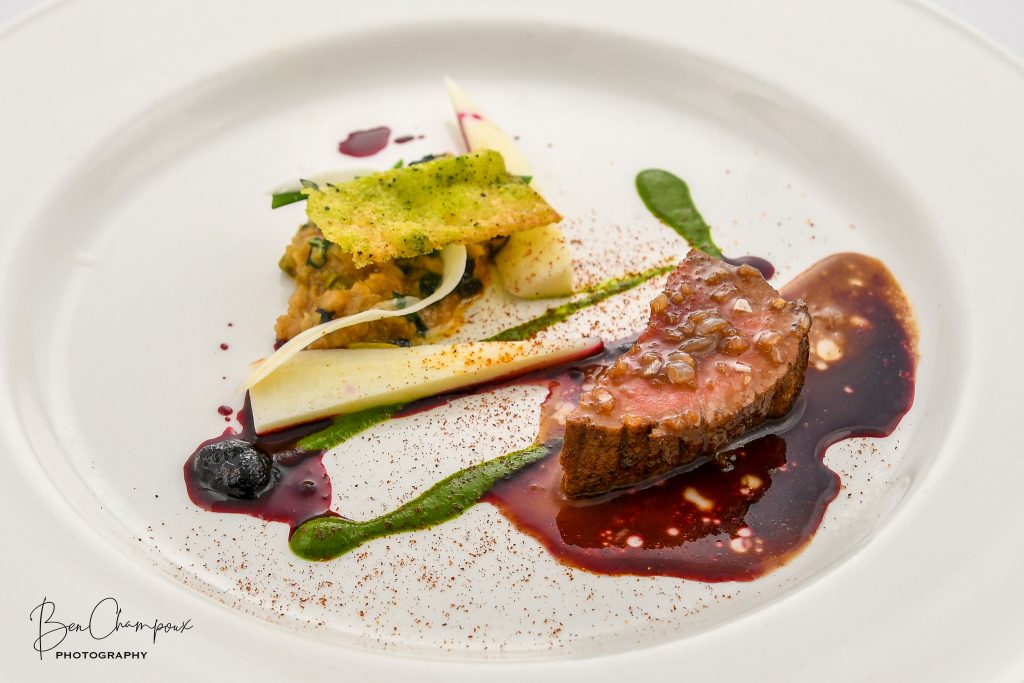 Chef Keith Pears (Toronto) was the next competitor. He carefiully cut away the silverskin from the elk then spiced the lean muscle with chili and lemon juice, pan-seared it then roasted it off in the oven, tenderizing it quite effectively. He seared the silverskin then used it to make a jus with red wine and shallots. The kale, oatmeal and fiddleheads joined forces in a cheese-enriched risotto. Then the kale returned for an encore as a tangy salsa verde spiced with chili and cumin which Chef piped in three little stripes on the plate. A crunchy wand of pickled parsley root accounted for that ingredient but Chef used it again to curl ribbons of raw root over his risotto. The haskaps became a well-judged gastrique and Chef made a crisp, sweet little cookie with the plankton.
Chef Keith Pears (Toronto) was the next competitor. He carefiully cut away the silverskin from the elk then spiced the lean muscle with chili and lemon juice, pan-seared it then roasted it off in the oven, tenderizing it quite effectively. He seared the silverskin then used it to make a jus with red wine and shallots. The kale, oatmeal and fiddleheads joined forces in a cheese-enriched risotto. Then the kale returned for an encore as a tangy salsa verde spiced with chili and cumin which Chef piped in three little stripes on the plate. A crunchy wand of pickled parsley root accounted for that ingredient but Chef used it again to curl ribbons of raw root over his risotto. The haskaps became a well-judged gastrique and Chef made a crisp, sweet little cookie with the plankton.
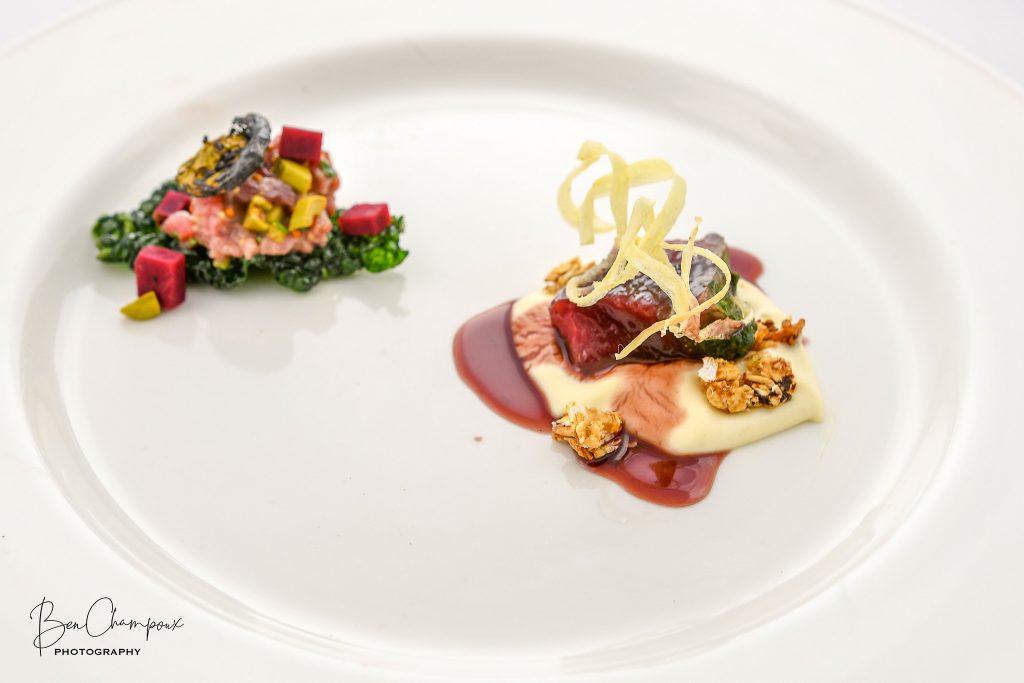 Chef number six was Emily Butcher (Winnipeg) who decided she had time to prepare the elk in two very different ways. On the left of the plate she presented a hand-chopped tartare sharpened with mustard and topped with a pickled fiddlehead and a brunoise of pickled beets and onion confit, all set on a crispy kale chip. On the right were small slices of the rare-seared elk crusted in miso and plankton powder, its marine flavour deliciously pronounced. The meat lay on a pillow of creamy parsley root purée, surrounded by two or three tiny clumps of sweet-and-savoury toasted oatmeal granola. Chef turned the haskaps into a jus using stock from the pantry – as meaty as it was fruity – and spooned it over the seared elk. Crispy ribbons of fried parsley root topped that side of things. It was basically two dishes in one – ambitious, given the time restraints – but triumphantly achieved.
Chef number six was Emily Butcher (Winnipeg) who decided she had time to prepare the elk in two very different ways. On the left of the plate she presented a hand-chopped tartare sharpened with mustard and topped with a pickled fiddlehead and a brunoise of pickled beets and onion confit, all set on a crispy kale chip. On the right were small slices of the rare-seared elk crusted in miso and plankton powder, its marine flavour deliciously pronounced. The meat lay on a pillow of creamy parsley root purée, surrounded by two or three tiny clumps of sweet-and-savoury toasted oatmeal granola. Chef turned the haskaps into a jus using stock from the pantry – as meaty as it was fruity – and spooned it over the seared elk. Crispy ribbons of fried parsley root topped that side of things. It was basically two dishes in one – ambitious, given the time restraints – but triumphantly achieved.
 Chef Marc-André Jetté (Montreal) was the next chef to bring his plates into the judging chamber. He had seared the elk in a very hot pan to generate a lovely charred flavour to its crust then popped it into a sous vide bag to tenderize it. Et voila! Seared elk tataki that might have been tenderloin. He made crispy kale chips and dusted them with plankton powder, chopped the marinated fiddleheads and scattered them on top, then toasted an oatmeal crumble with butter and salt and did the same thing with that. Parsley root was dealt with in two ways – as crispy chips that looked like fettucine and as a purée that Chef Jetté sharpened with lemon as a contrast to the meat. He poached the haskap berries in a light syrup without letting each berry lose its integrity, accentuating its sweet-tart flavour. Another very fine dish from Chef Jetté.
Chef Marc-André Jetté (Montreal) was the next chef to bring his plates into the judging chamber. He had seared the elk in a very hot pan to generate a lovely charred flavour to its crust then popped it into a sous vide bag to tenderize it. Et voila! Seared elk tataki that might have been tenderloin. He made crispy kale chips and dusted them with plankton powder, chopped the marinated fiddleheads and scattered them on top, then toasted an oatmeal crumble with butter and salt and did the same thing with that. Parsley root was dealt with in two ways – as crispy chips that looked like fettucine and as a purée that Chef Jetté sharpened with lemon as a contrast to the meat. He poached the haskap berries in a light syrup without letting each berry lose its integrity, accentuating its sweet-tart flavour. Another very fine dish from Chef Jetté.
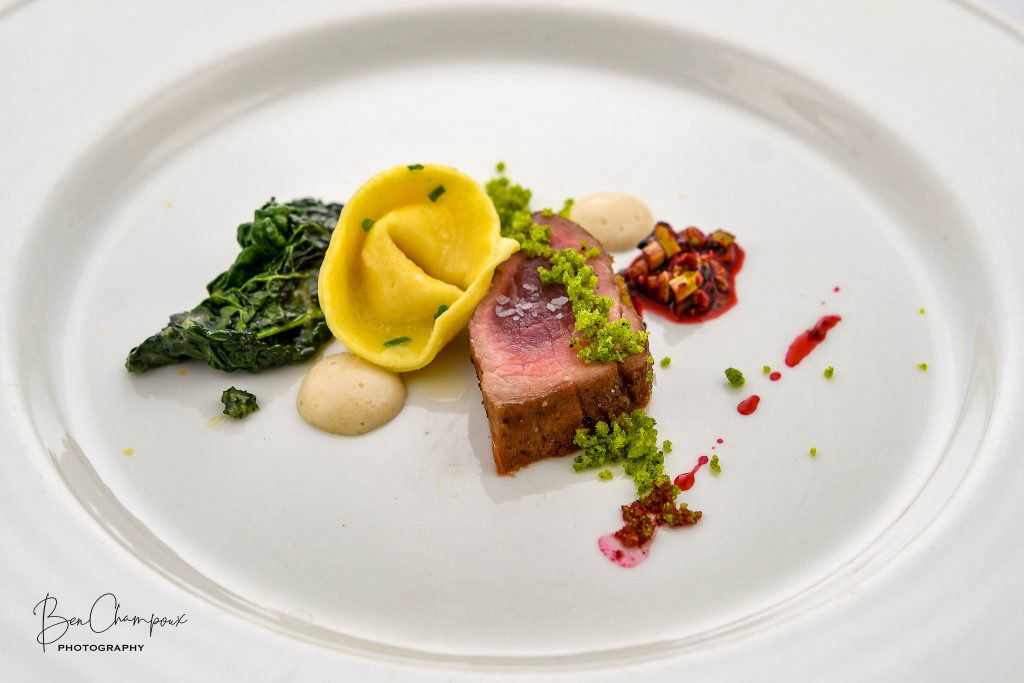 Our eighth dish was created by Chef JP Dublado (Edmonton). He pan-seared the elk and cut it into thick steaks, flanking it with miso-braised kale that also made good use of the plankton powder and shallots from the pantry. Chef combined the fiddleheads and haskap berries into a zesty salsa (a spoonful lay beside the meat) and used the plankton again, stirred with panko crumbs and butter, to mke a festive-looking green crumble. The parsley root became a purée with which Chef filled swiftly-made tortellini. He made a purée from the oatmeal and piped two little mounds of it either side of the elk.
Our eighth dish was created by Chef JP Dublado (Edmonton). He pan-seared the elk and cut it into thick steaks, flanking it with miso-braised kale that also made good use of the plankton powder and shallots from the pantry. Chef combined the fiddleheads and haskap berries into a zesty salsa (a spoonful lay beside the meat) and used the plankton again, stirred with panko crumbs and butter, to mke a festive-looking green crumble. The parsley root became a purée with which Chef filled swiftly-made tortellini. He made a purée from the oatmeal and piped two little mounds of it either side of the elk.
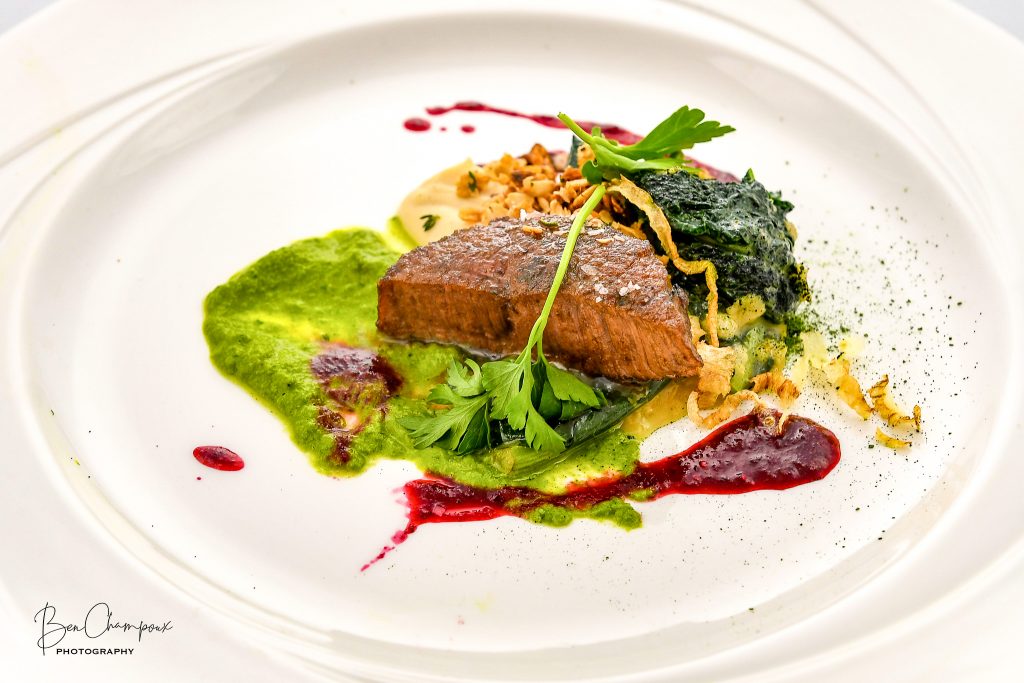 Chef Kyle Puddester (Newfoundland) presented ninth, searing and roasting his elk to medium doneness then dusting it lightly with the plankton powder. More plankton flavoured a savoury porridge made with the oatmeal and Chef stirred in large leaves of wilted kale. The fiddleheads appeared as a finely textured chimichurri, fresh and tasty, while the oatmeal returned as a pan-toasted crumble to add crunch. Parsley root was fried into crispy ribbons and also turned into a voluptuous purée with lots of brown butter and thyme. Parsley tops were a final garnish. Chef used onion, garlic, chili and cumin to transform the haskap berries into a gently tangy barbecue sauce that worked like ketchup with the meat.
Chef Kyle Puddester (Newfoundland) presented ninth, searing and roasting his elk to medium doneness then dusting it lightly with the plankton powder. More plankton flavoured a savoury porridge made with the oatmeal and Chef stirred in large leaves of wilted kale. The fiddleheads appeared as a finely textured chimichurri, fresh and tasty, while the oatmeal returned as a pan-toasted crumble to add crunch. Parsley root was fried into crispy ribbons and also turned into a voluptuous purée with lots of brown butter and thyme. Parsley tops were a final garnish. Chef used onion, garlic, chili and cumin to transform the haskap berries into a gently tangy barbecue sauce that worked like ketchup with the meat.
 What did Chef Darren Craddock (Saskatoon) make of the box? He seared the elk, cooking it through but not mitigating the eye-of-round texture. He used the oatmeal to make a robust and delicious oatcake, a solid base for the elk which he kept in place with a dab of cream cheese. Fiddlehead tempura was a lovely idea, capturing the fern’s complex flavour. Chef wilted the kale in a pan and made a purée of the parsley root, bolstered with carrot and warm curry spices. A tangy plankton cream served as a second sauce while the haskaps became a sweet jam, spooned over the elk. Julienned carrot and slices of pickled shiitaki completed the dish.
What did Chef Darren Craddock (Saskatoon) make of the box? He seared the elk, cooking it through but not mitigating the eye-of-round texture. He used the oatmeal to make a robust and delicious oatcake, a solid base for the elk which he kept in place with a dab of cream cheese. Fiddlehead tempura was a lovely idea, capturing the fern’s complex flavour. Chef wilted the kale in a pan and made a purée of the parsley root, bolstered with carrot and warm curry spices. A tangy plankton cream served as a second sauce while the haskaps became a sweet jam, spooned over the elk. Julienned carrot and slices of pickled shiitaki completed the dish.
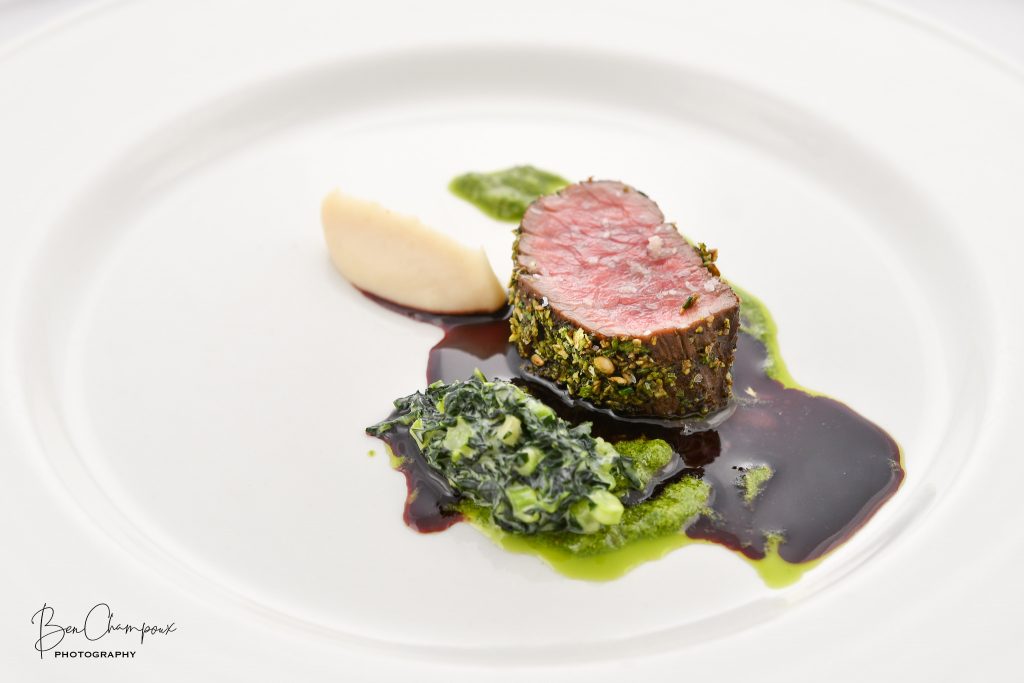 Chef Barry Mooney (Halifax) was the eleventh contestant, poaching the elk before pan-roasting it with butter, garlic and thyme. Rolled in a plankton and oat crust, it was flavourful and relatively tender. Creaming the kale with a little ale from the pantry brought out its brassica personality, while the purée Chef made from the parsley root was as rich as cream and as smooth as satin. The fiddleheads and parsley tops became a lovely gremolata. Beef stock from the pantry was the key to the haskap question. Chef reduced the berries with a mixture of pantry herbs until they turned into a gorgeous demiglace.
Chef Barry Mooney (Halifax) was the eleventh contestant, poaching the elk before pan-roasting it with butter, garlic and thyme. Rolled in a plankton and oat crust, it was flavourful and relatively tender. Creaming the kale with a little ale from the pantry brought out its brassica personality, while the purée Chef made from the parsley root was as rich as cream and as smooth as satin. The fiddleheads and parsley tops became a lovely gremolata. Beef stock from the pantry was the key to the haskap question. Chef reduced the berries with a mixture of pantry herbs until they turned into a gorgeous demiglace.
 Chef Roger Ma (Vancouver) was the last to be allowed out of the holding room and back into the world. He roasted his elk to perfection – it was the tenderest treatment of the morning – first rolling it in an eggwash and then crusting it with a powder made from the oatmeal, thyme, garlic and a pinch of star anise. The fiddleheads and plankton became a pickled relish for the meat. Chef Ma cut his kale into postage stamps, braised them and set one on each plate, topping them with threads of raw parsley root. More parsley root appeared as two crispy threads sticking vertically our of a mound of parsley root purée that was rich, thickly textured and tasted intensely of itself. The parsley tops, meanwhile, gave colour to a green oil with which Chef finished the plate. A haskap gastrique, sharpened with red wine, vinegar, sugar and shallots was all that a gastrique can be.
Chef Roger Ma (Vancouver) was the last to be allowed out of the holding room and back into the world. He roasted his elk to perfection – it was the tenderest treatment of the morning – first rolling it in an eggwash and then crusting it with a powder made from the oatmeal, thyme, garlic and a pinch of star anise. The fiddleheads and plankton became a pickled relish for the meat. Chef Ma cut his kale into postage stamps, braised them and set one on each plate, topping them with threads of raw parsley root. More parsley root appeared as two crispy threads sticking vertically our of a mound of parsley root purée that was rich, thickly textured and tasted intensely of itself. The parsley tops, meanwhile, gave colour to a green oil with which Chef finished the plate. A haskap gastrique, sharpened with red wine, vinegar, sugar and shallots was all that a gastrique can be.
And suddenly the morning was over. Chefs jumped onto the coach back to the Shaw Centre to start prepping their dishes for the Grand Finale; we judges retired to a boardroom in the Lord Elgin to ponder our scores, hoping (ungratefully) that elk was not on the menu tonight. The tightly grouped pack of competitors was beginning to loosen a little. Two chefs had been penalized for going over time by some seconds, but it did not jeopardize their positions to a great degree. Four chefs had pulled away a little from the gastronomic peleton; four more still had them in their sights. Going into the Grand Finale, it was still an open race.
The Grand Finale
If you weren’t there, let me say that the Grand Finale was like one of our regional Kitchen Party events – glamorous, full of action, amazing music and world-class Olympic athletes – only this time the chefs were definitely front and centre. We sold out the event long ago and the crowd of 650 were eager to try every one of the 12 plates in the room. Whether they managed to, I can not say, as the judges tasted their own plates behind the relative privacy of a black curtain. And spectacular plates they were! Knowing what was coming, I was able to order them in a rational way for the judges.
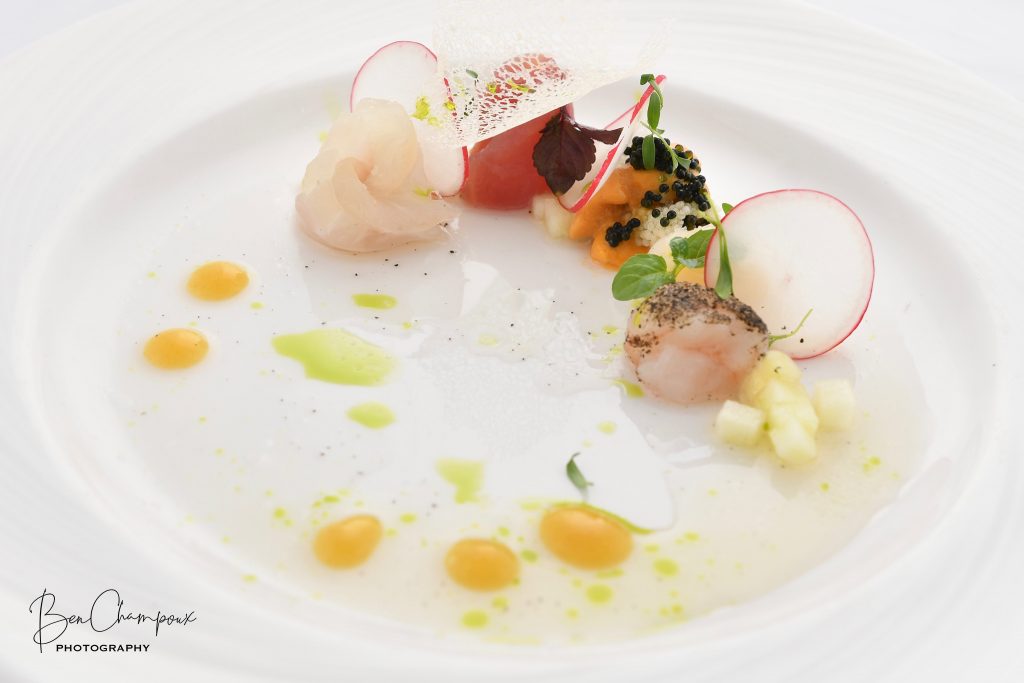 We began with Chef Jenny M. Kang of Shokunin Izakaya, in Calgary, who called her dish Sea Garden Eden. Its structure was simple – five impeccably fresh kinds of seafood arranged in a curving row – just a single bite of each – and I’ll start by describing them. First a wild B.C. side stripe shrimp gently cured in a bath of iced sake, salt and water then rolled in nori powder. A single plump slice of this was set onto each plate. Nestled up beside it was a rosette of very finely sliced raw Hokkaido scallop, as sweet and fresh in its way as the shrimp. Then a rice and nori crisp like a tiny pillow topped with gorgeously delicate fresh B.C. sea urchin, itself crowned with a tiny portion of black herring roe. Beside this we found a curl of aged raw ahi tuna, and finally a roll of New Zealand snapper cured by pressing it for five hours between kelp sheets with a touch of yuzu – just enough to enhance but not mask the fish’s own natural flavour. What made the dish so special was the sauce – a clear but quite viscous take on Vietnamese nuoc cham but using citrussy yuzu instead of chili heat. It was funky, powerful, complex and added a whole new south Asian dimension to what was otherwise a straightforward Japanese presentation. To garnish the dish Chef added a number of intensely flavourful grace notes – a brunoise of tart green apple, some dots of yuzu gel, tissue-thin slices of radish and finally an ethereal tuile like a crispy golden net made with fried apple juice. It was all so exquisite and Chef’s chice of wine was inspired – an off-dry bubbly from Summerland, BC, called Evolve Élan Effervescence that picked up the citrus components and the natural sweetness of the seafood admirably well.
We began with Chef Jenny M. Kang of Shokunin Izakaya, in Calgary, who called her dish Sea Garden Eden. Its structure was simple – five impeccably fresh kinds of seafood arranged in a curving row – just a single bite of each – and I’ll start by describing them. First a wild B.C. side stripe shrimp gently cured in a bath of iced sake, salt and water then rolled in nori powder. A single plump slice of this was set onto each plate. Nestled up beside it was a rosette of very finely sliced raw Hokkaido scallop, as sweet and fresh in its way as the shrimp. Then a rice and nori crisp like a tiny pillow topped with gorgeously delicate fresh B.C. sea urchin, itself crowned with a tiny portion of black herring roe. Beside this we found a curl of aged raw ahi tuna, and finally a roll of New Zealand snapper cured by pressing it for five hours between kelp sheets with a touch of yuzu – just enough to enhance but not mask the fish’s own natural flavour. What made the dish so special was the sauce – a clear but quite viscous take on Vietnamese nuoc cham but using citrussy yuzu instead of chili heat. It was funky, powerful, complex and added a whole new south Asian dimension to what was otherwise a straightforward Japanese presentation. To garnish the dish Chef added a number of intensely flavourful grace notes – a brunoise of tart green apple, some dots of yuzu gel, tissue-thin slices of radish and finally an ethereal tuile like a crispy golden net made with fried apple juice. It was all so exquisite and Chef’s chice of wine was inspired – an off-dry bubbly from Summerland, BC, called Evolve Élan Effervescence that picked up the citrus components and the natural sweetness of the seafood admirably well.
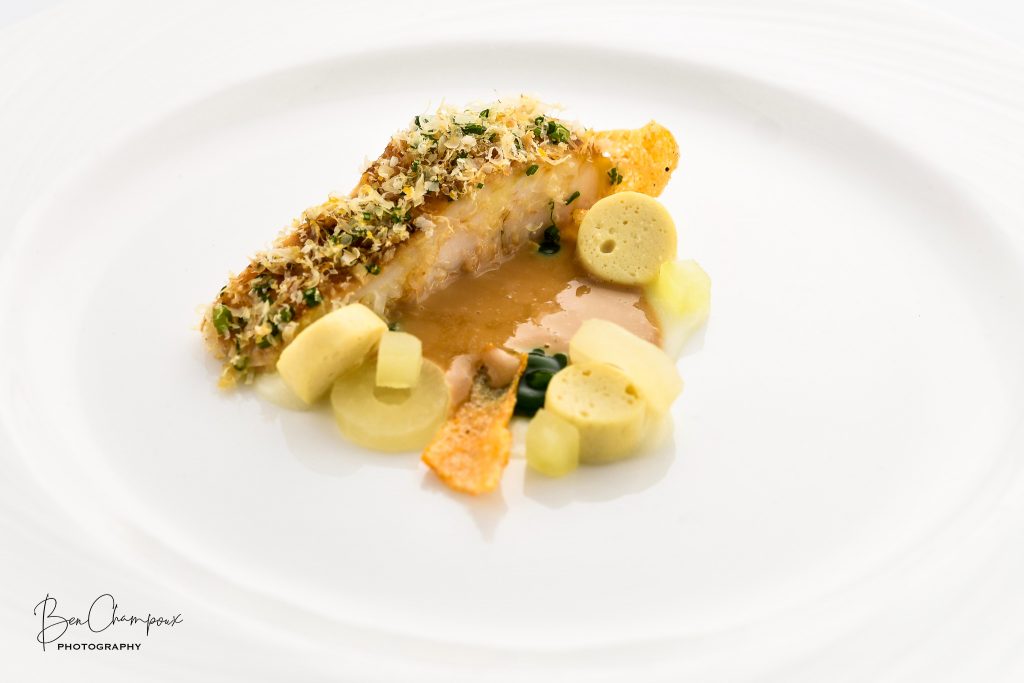 Chef Barry Mooney of Fresh Twenty One, in Dartmouth, Nova Scotia, presented the second dish. He had set himself the task of interpreting sturgeon caught in the St. John river, New Brunswick, without any reference to caviar. So we were presented with a finger of sturgeon belly, lightly cured with koji that chef had cultivated from sushi rice in his kitchen, then hot-smoked with applewood. The moist fish was then glazed with a fermented koji and soy lacquer that burst onto the taste buds. Close by were little drums of delicately flavoured, moussy sturgeon boudin blanc, and discs of daikon poached in kombu-infused chicken stock, each one the size of a quarter. Chef had also used the sturgeon bones and cartilege, cooking them under pressure then puréeing, dehydrating and turning them into ethereal little crisps, lightly seasoned with togerashi spice. Little dots of creamy apple purée and even smaller dots of green parsley purée played minor roles but the principal sauce was a gorgeous tonkatsu emulsion of reduced chicken stock and cider vinegar. In terms of technique and imagination, the dish was a tour de force, its richness nicely balanced by a great Nova Scotian bubbly, Benjamin Bridge Small Lot, Late Disgorged NV Brut.
Chef Barry Mooney of Fresh Twenty One, in Dartmouth, Nova Scotia, presented the second dish. He had set himself the task of interpreting sturgeon caught in the St. John river, New Brunswick, without any reference to caviar. So we were presented with a finger of sturgeon belly, lightly cured with koji that chef had cultivated from sushi rice in his kitchen, then hot-smoked with applewood. The moist fish was then glazed with a fermented koji and soy lacquer that burst onto the taste buds. Close by were little drums of delicately flavoured, moussy sturgeon boudin blanc, and discs of daikon poached in kombu-infused chicken stock, each one the size of a quarter. Chef had also used the sturgeon bones and cartilege, cooking them under pressure then puréeing, dehydrating and turning them into ethereal little crisps, lightly seasoned with togerashi spice. Little dots of creamy apple purée and even smaller dots of green parsley purée played minor roles but the principal sauce was a gorgeous tonkatsu emulsion of reduced chicken stock and cider vinegar. In terms of technique and imagination, the dish was a tour de force, its richness nicely balanced by a great Nova Scotian bubbly, Benjamin Bridge Small Lot, Late Disgorged NV Brut.
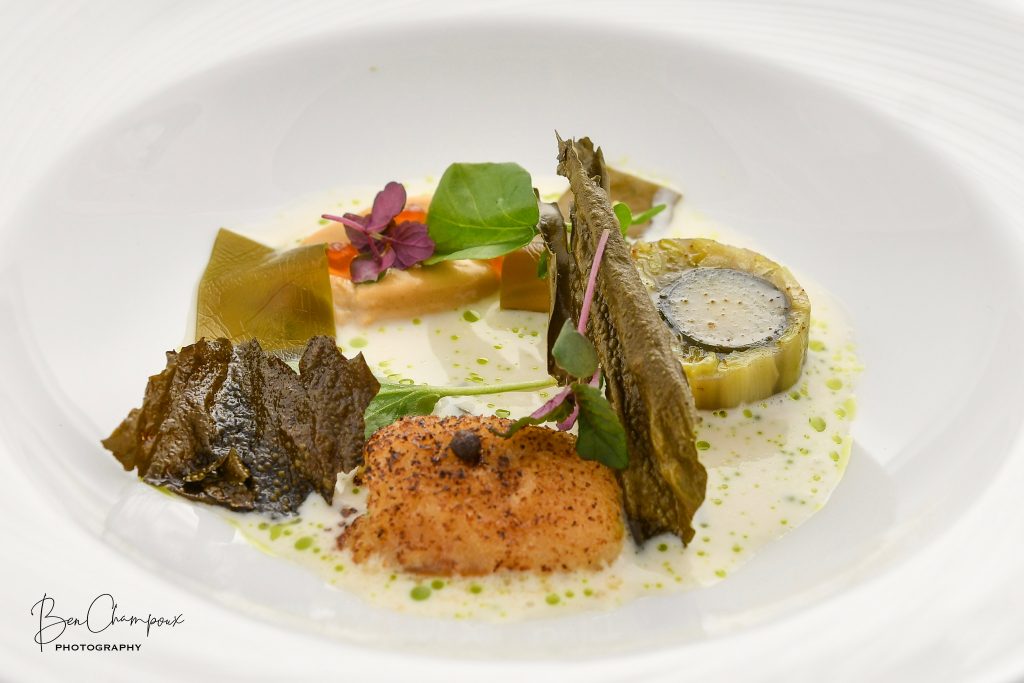 Chef Roger Ma of Boulevard Kitchen and Oyster Bar, in Vancouver, was third up, offering a meticulously detailed, almost intellectual exploration of B.C.’s coastal terroir. There were many small but perfect elements on the plate. Leading the way was a single honey mussel, farmed on Lasqueti Island. Chef steamed it then gratinéed it with a miso butter crust and a hint of preserved sansho pepper. A caramel-coloured disc of custard turned out to be made from sea urchin cooked with dashi and set with carrageenan; dots of meyer lemon purée and three salmon eggs, like tiny rubies, flattered the custard most charmingly. “This is my version of “surf and turf” said Chef, indicating a slice of potato and scallion terrine set in a gelee of clam and mussel nectar. Its heart was a quarter-sized cirle of Yukon Gold that had been poached in an umami-rich shellfish stock then wrapped with bull kelp. More of the wild, hand-harvested kelp garnished the dish, some lightly pickled, other fronds marinated in soy then fried to a crisp, The finishing touch was a lightweight, milky nage made from clam juice and dashi. It was a fascinating symphony of flavours, every mouthful bringing a uniquely different experience. Chef’s wine match was exceptionally well chosen – the bright, sturdy 2018 Unicus Grüner Veltliner from Culmina Family Estate Winery.
Chef Roger Ma of Boulevard Kitchen and Oyster Bar, in Vancouver, was third up, offering a meticulously detailed, almost intellectual exploration of B.C.’s coastal terroir. There were many small but perfect elements on the plate. Leading the way was a single honey mussel, farmed on Lasqueti Island. Chef steamed it then gratinéed it with a miso butter crust and a hint of preserved sansho pepper. A caramel-coloured disc of custard turned out to be made from sea urchin cooked with dashi and set with carrageenan; dots of meyer lemon purée and three salmon eggs, like tiny rubies, flattered the custard most charmingly. “This is my version of “surf and turf” said Chef, indicating a slice of potato and scallion terrine set in a gelee of clam and mussel nectar. Its heart was a quarter-sized cirle of Yukon Gold that had been poached in an umami-rich shellfish stock then wrapped with bull kelp. More of the wild, hand-harvested kelp garnished the dish, some lightly pickled, other fronds marinated in soy then fried to a crisp, The finishing touch was a lightweight, milky nage made from clam juice and dashi. It was a fascinating symphony of flavours, every mouthful bringing a uniquely different experience. Chef’s wine match was exceptionally well chosen – the bright, sturdy 2018 Unicus Grüner Veltliner from Culmina Family Estate Winery.
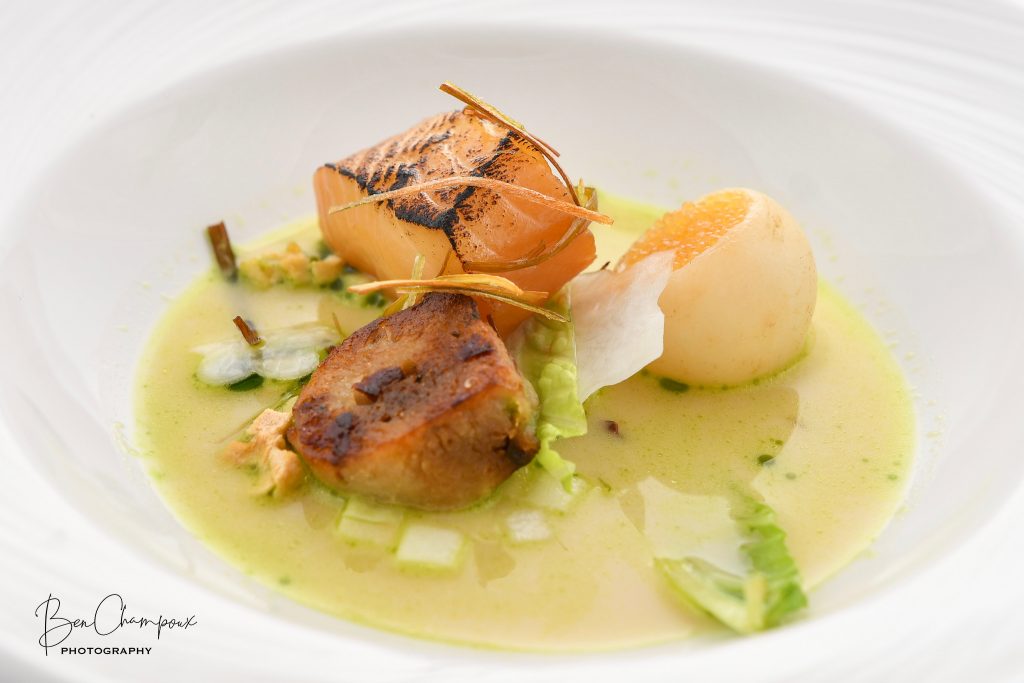 Our fourth contestant was Chef Emily Butcher of deer + almond, in Winnipeg, who taught us exactly what happens to turnips when they go to heaven. There was protein on the plate – a chunk of sable fish cured in birch syrup to add sweetness to its delicate, flaky petals – but turnips stole the show. Here was a square of turnip cake studded with porcini and chunks of a sweet, sticky, Chinese-style pork sausage Chef seasoned with rice wine, soy and cinnamon then fermented and hung for two weeks. Baby Tokyo turnips were served two ways – some sliced as thinly as rice paper and served raw, another lightly poached and then partially hollowed to be filled with yellow whitefish roe, mimicking a boiled egg. Other elements included raw apple brunoise and chewy chunks of candied apple; fermented crabapple gel made its own subtly bittersweet point and motes of crispy leek and sorrel were there for those who sought them. Bringing everything together was a warm broth that Chef poured into our bowls at the table – a stock of fermented turnip juice and caramelized turnip, enriched and soothed with butter and cream and a trace of celery-fennel oil. Chef’s match was universally approved – the edgy 2018 Pinot Gris from Tightrope, on B.C.’s Naramata Bench.
Our fourth contestant was Chef Emily Butcher of deer + almond, in Winnipeg, who taught us exactly what happens to turnips when they go to heaven. There was protein on the plate – a chunk of sable fish cured in birch syrup to add sweetness to its delicate, flaky petals – but turnips stole the show. Here was a square of turnip cake studded with porcini and chunks of a sweet, sticky, Chinese-style pork sausage Chef seasoned with rice wine, soy and cinnamon then fermented and hung for two weeks. Baby Tokyo turnips were served two ways – some sliced as thinly as rice paper and served raw, another lightly poached and then partially hollowed to be filled with yellow whitefish roe, mimicking a boiled egg. Other elements included raw apple brunoise and chewy chunks of candied apple; fermented crabapple gel made its own subtly bittersweet point and motes of crispy leek and sorrel were there for those who sought them. Bringing everything together was a warm broth that Chef poured into our bowls at the table – a stock of fermented turnip juice and caramelized turnip, enriched and soothed with butter and cream and a trace of celery-fennel oil. Chef’s match was universally approved – the edgy 2018 Pinot Gris from Tightrope, on B.C.’s Naramata Bench.
 The fifth dish we tried came from Chef Matt Pennell of Legends, in Moncton. The dish itself was named Salt Water Joys, a moniker taken from the song by Buddy Wasisname and the Other Fellers, apparently very popular in the Pennell household when Chef was a lad. At its heart was a piece of superb Nova Scotian lamb loin that had been brined in seawater, cooked sous vide and was served crusted with a delicate green herb powder. Beside it, as a bonus, was a thick slice of slow-roasted lamb belly, its crispness layered with delectable fat and creating a lovely contrast with the lean loin. Tuna was an unexpected companion but chef had worked magic, curing then air-drying it for a month until it was more like a funky bresaola than fish, then slicing it into little curls. Part of the clever presentation involved piping a D of sea-buckthorn-flavoured egg custard onto the plate and then filling in the yellow outline with a rich lamb jus. We also found a thin slice of lightly smoked and preserved king mushroom and dots of puréed kimchi that brought a nice fermented note to the proceedings. Crisp fragments of deep-fried green kelp were the final saltwater reference. Chef’s pairing was a sparkling wine made mostly from Frontenac grapes, the Brut Classic from Motts Landing in Cambridge Narrows, New Brunswick.
The fifth dish we tried came from Chef Matt Pennell of Legends, in Moncton. The dish itself was named Salt Water Joys, a moniker taken from the song by Buddy Wasisname and the Other Fellers, apparently very popular in the Pennell household when Chef was a lad. At its heart was a piece of superb Nova Scotian lamb loin that had been brined in seawater, cooked sous vide and was served crusted with a delicate green herb powder. Beside it, as a bonus, was a thick slice of slow-roasted lamb belly, its crispness layered with delectable fat and creating a lovely contrast with the lean loin. Tuna was an unexpected companion but chef had worked magic, curing then air-drying it for a month until it was more like a funky bresaola than fish, then slicing it into little curls. Part of the clever presentation involved piping a D of sea-buckthorn-flavoured egg custard onto the plate and then filling in the yellow outline with a rich lamb jus. We also found a thin slice of lightly smoked and preserved king mushroom and dots of puréed kimchi that brought a nice fermented note to the proceedings. Crisp fragments of deep-fried green kelp were the final saltwater reference. Chef’s pairing was a sparkling wine made mostly from Frontenac grapes, the Brut Classic from Motts Landing in Cambridge Narrows, New Brunswick.
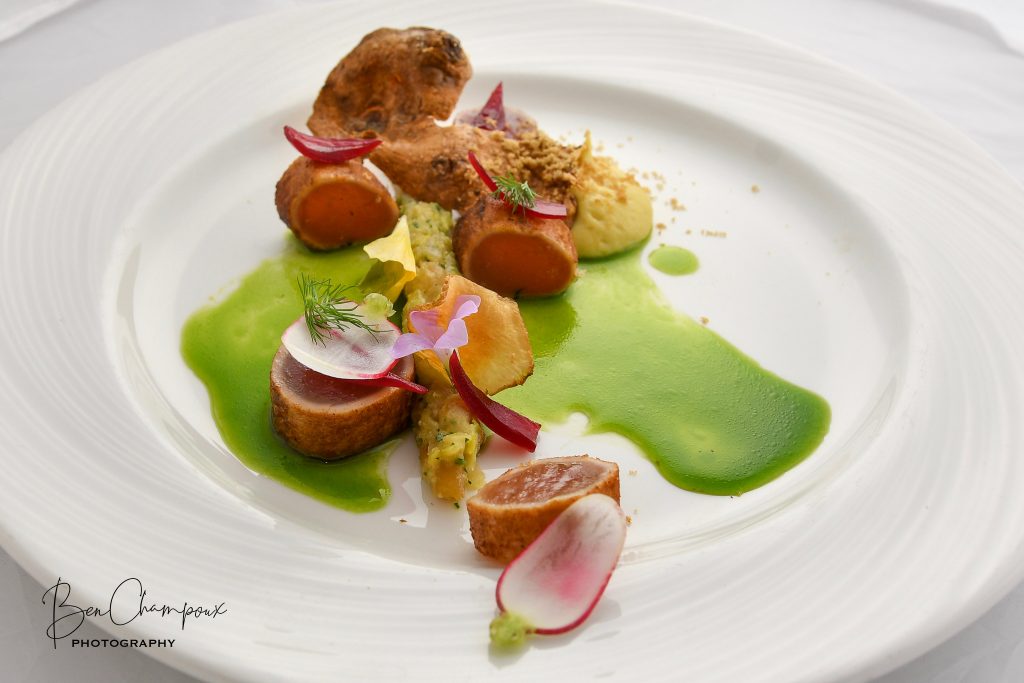 Chef Keith Pears from W hotel in Toronto presented next. He called his dish “West Meets East,” a reference to his roots on Canada’s west coast and his current career in Toronto. B.C. was the source for his principal ingredient, gorgeous albacore tuna, cut into tiny drums, rubbed with miso and dashi and very briefly seared. Nestled between the pieces of tuna was a soft tube of mashed sunchoke, leek and caramelized Granny Smith apple, scented with parsley, thyme and chive. A rich leek foam was spooned onto the plate, garnished with tiny red petals of pickled pearl onion. Urban honey from beehives in Tronto’s Riverdale neighbourhood brought a subtle sweetness to a yuzu oil, its unique citrus flavour echoing the Japanese flavours of the miso and dashi. Crispy chips made of sunchoke and, more unusually, sunchoke skin provided textural contrast and a sprinkle of powdered sunchoke finished the dish, with edible flowers and dill fronds for prettiness. The flavours were intense but perfectly harmonious and the wine match was flawless – the rich, complex, wild-fermented Reserve du Domaine 2017 Chardonnay from Domaine Queylus in Niagara.
Chef Keith Pears from W hotel in Toronto presented next. He called his dish “West Meets East,” a reference to his roots on Canada’s west coast and his current career in Toronto. B.C. was the source for his principal ingredient, gorgeous albacore tuna, cut into tiny drums, rubbed with miso and dashi and very briefly seared. Nestled between the pieces of tuna was a soft tube of mashed sunchoke, leek and caramelized Granny Smith apple, scented with parsley, thyme and chive. A rich leek foam was spooned onto the plate, garnished with tiny red petals of pickled pearl onion. Urban honey from beehives in Tronto’s Riverdale neighbourhood brought a subtle sweetness to a yuzu oil, its unique citrus flavour echoing the Japanese flavours of the miso and dashi. Crispy chips made of sunchoke and, more unusually, sunchoke skin provided textural contrast and a sprinkle of powdered sunchoke finished the dish, with edible flowers and dill fronds for prettiness. The flavours were intense but perfectly harmonious and the wine match was flawless – the rich, complex, wild-fermented Reserve du Domaine 2017 Chardonnay from Domaine Queylus in Niagara.
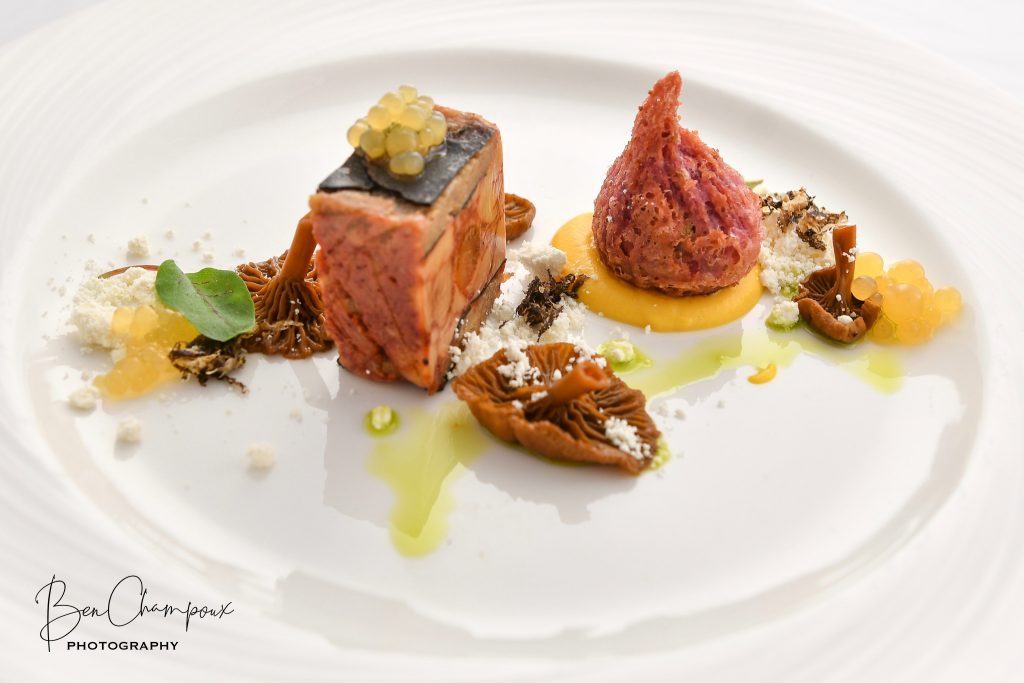 Halfway through… But the judges were still hungry. In the nick of time, Chef JP Dublado from River Cree Resort and Casino appeared with his dish. At its heart stood a small block of a terrine made with pungent char siu foie gras, red and yellow bean paste, cured duck egg yolk, duck confit and four layers of truffle – a gorgeous umami bomb. Beside this was a curious vermilion dumpling that tapered up to a point. The surface was mashed purple ube yam, crisply fried, while inside we discovered rich and flavourful chicken rillettes. All sorts of little treats surrounded these two items, so that each mouthful was an entirely fresh experience. Here were little drums of kiwi fruit and tangy soy-pickled baby chanterelles. Over there was a pool of silky yellow purée made from parsnip, carrot and brown butter. Calamansi pearls, tart with verjus and green tea, added a sharp component; white foie gras powder brought more soft fat to the party. More Burgundy truffles had been grated in a couple of places to gild the lily once and for all. Chef’s wine was a fine match, the opulently aromatic 2018 Sauvignon Blanc-Semillon blend from Howling Bluff on B.C.’s Naramata Bench, its passion fruit intensity standing up well to the big flavours of the dish.
Halfway through… But the judges were still hungry. In the nick of time, Chef JP Dublado from River Cree Resort and Casino appeared with his dish. At its heart stood a small block of a terrine made with pungent char siu foie gras, red and yellow bean paste, cured duck egg yolk, duck confit and four layers of truffle – a gorgeous umami bomb. Beside this was a curious vermilion dumpling that tapered up to a point. The surface was mashed purple ube yam, crisply fried, while inside we discovered rich and flavourful chicken rillettes. All sorts of little treats surrounded these two items, so that each mouthful was an entirely fresh experience. Here were little drums of kiwi fruit and tangy soy-pickled baby chanterelles. Over there was a pool of silky yellow purée made from parsnip, carrot and brown butter. Calamansi pearls, tart with verjus and green tea, added a sharp component; white foie gras powder brought more soft fat to the party. More Burgundy truffles had been grated in a couple of places to gild the lily once and for all. Chef’s wine was a fine match, the opulently aromatic 2018 Sauvignon Blanc-Semillon blend from Howling Bluff on B.C.’s Naramata Bench, its passion fruit intensity standing up well to the big flavours of the dish.
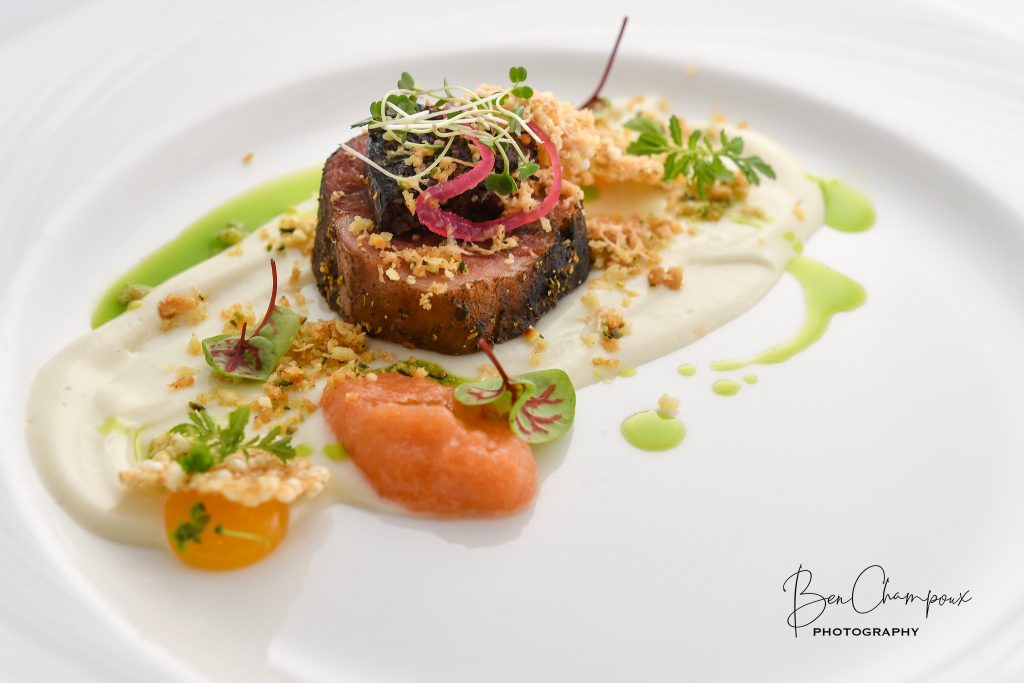 Our eighth plate was the work of Chef Darren Craddock from Village Bistro, in Saskatoon. He chose to work with wild boar from Golden Prairie Farms, cooking the neck meat sous vide as a chunky roulade flavoured with fennel pollen and striated with black tracings of carbonized onion ash. Chef took the wild boar blood and made it into a boudin noir with back fat, oats, cream and a little judicious spicing – a toonie-sized puck of it was set atop the roulade and crowned with a piece of frozen foie gras torchon that melted luxuriously over the blood pudding. Quince appeared in two guises – poached in syrup then cut into tiny dice; and as a smooth pink preserve. Summer apricots became a gel – three intensely flavourful dots to dab onto the meat. Textural contrast came in several forms: here as a tapioca crisp made with dehydrated and powdered chanterelles; there as a crumble of wild boar chicharon. Fennel pollen and a tiny ring of pickled onion completed the plate, with a sprinkling of microgreens (wild arugula, tangerine lace and red vein sorrel). It was a fine creation, focused on the wild boar but surrounding the meat with so many tantalizing details. The wine Chef Craddock chose was gorgeous and also worked very well with the dish – Closson Chase 2017 South Clos Chardonnay from Prince Edward County, Ontario.
Our eighth plate was the work of Chef Darren Craddock from Village Bistro, in Saskatoon. He chose to work with wild boar from Golden Prairie Farms, cooking the neck meat sous vide as a chunky roulade flavoured with fennel pollen and striated with black tracings of carbonized onion ash. Chef took the wild boar blood and made it into a boudin noir with back fat, oats, cream and a little judicious spicing – a toonie-sized puck of it was set atop the roulade and crowned with a piece of frozen foie gras torchon that melted luxuriously over the blood pudding. Quince appeared in two guises – poached in syrup then cut into tiny dice; and as a smooth pink preserve. Summer apricots became a gel – three intensely flavourful dots to dab onto the meat. Textural contrast came in several forms: here as a tapioca crisp made with dehydrated and powdered chanterelles; there as a crumble of wild boar chicharon. Fennel pollen and a tiny ring of pickled onion completed the plate, with a sprinkling of microgreens (wild arugula, tangerine lace and red vein sorrel). It was a fine creation, focused on the wild boar but surrounding the meat with so many tantalizing details. The wine Chef Craddock chose was gorgeous and also worked very well with the dish – Closson Chase 2017 South Clos Chardonnay from Prince Edward County, Ontario.
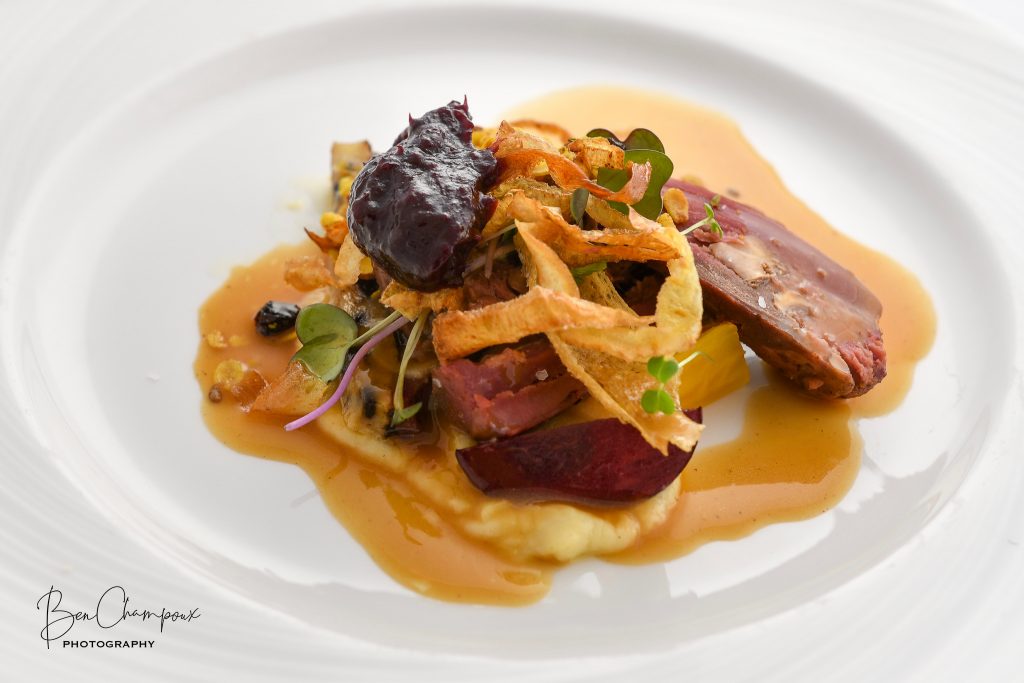 Chef Kyle Puddester of Fork, in Mobile, Newfoundland, was the next chef to show his quality to the judges. He had spent those snowbound days at his restaurant cleaning scores of wild willow partridge, hunted by a friend of his on the southern shore – beautiful and substantial birds. He cooked the breasts sous vide with thyme, rosemary, garlic and butter – the purple meat was wonderfully tender and moist and satisfyingly gamey. The breast was stuffed with a farce of leg meat, partridgeberry and mushroom, and it was wrapped in a thin slice of another breast that Chef had cured and air-dried. Beside the meat was a little parsnip and brown butter purée, and a bread pudding of caramelized onion, dried blueberries and thyme. The partridge livers became a rich, loose-textured mousse, at once spicy and sweet. The sauce was a jus made from the partridge bones while a compote of tangy, intensely flavourful partridgeberries was the most appropriate condiment imaginable. Chef finished the presentation with dried currant granola, morsels of fresh plum, pickled beet and crispy parsnip ribbons. He is a bit of a home brewer himself but to match this dish he showed it off to the brewers at Landwash Brewery and together they created a saison perfectly matched to its flavours which they called Rock & Willow, in honour of Newfoundland’s two kinds of partridge.
Chef Kyle Puddester of Fork, in Mobile, Newfoundland, was the next chef to show his quality to the judges. He had spent those snowbound days at his restaurant cleaning scores of wild willow partridge, hunted by a friend of his on the southern shore – beautiful and substantial birds. He cooked the breasts sous vide with thyme, rosemary, garlic and butter – the purple meat was wonderfully tender and moist and satisfyingly gamey. The breast was stuffed with a farce of leg meat, partridgeberry and mushroom, and it was wrapped in a thin slice of another breast that Chef had cured and air-dried. Beside the meat was a little parsnip and brown butter purée, and a bread pudding of caramelized onion, dried blueberries and thyme. The partridge livers became a rich, loose-textured mousse, at once spicy and sweet. The sauce was a jus made from the partridge bones while a compote of tangy, intensely flavourful partridgeberries was the most appropriate condiment imaginable. Chef finished the presentation with dried currant granola, morsels of fresh plum, pickled beet and crispy parsnip ribbons. He is a bit of a home brewer himself but to match this dish he showed it off to the brewers at Landwash Brewery and together they created a saison perfectly matched to its flavours which they called Rock & Willow, in honour of Newfoundland’s two kinds of partridge.
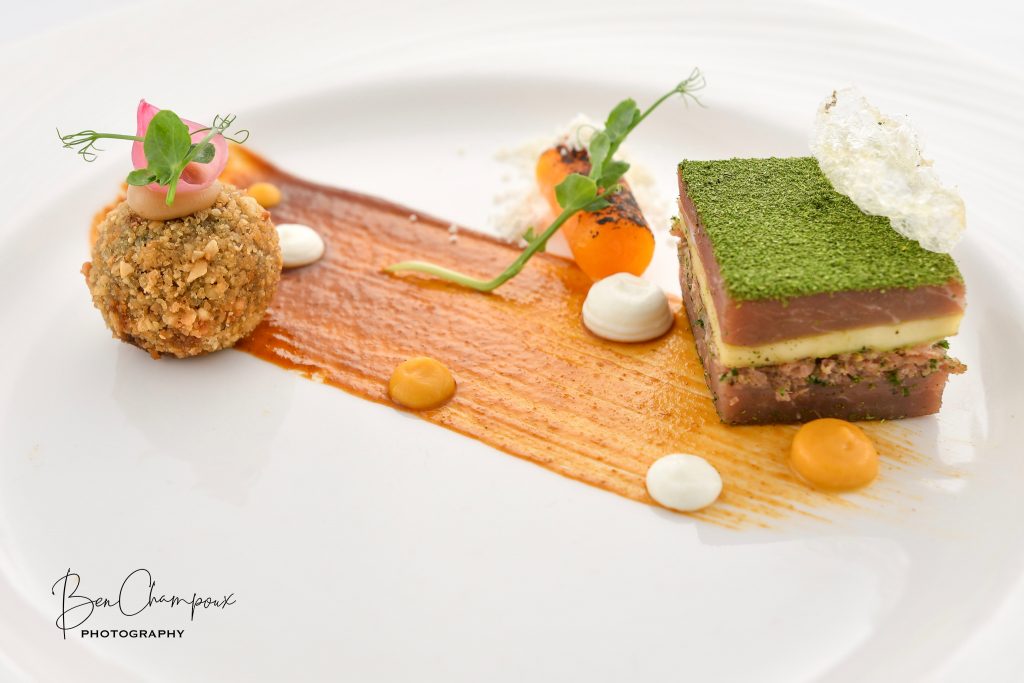 Our tenth plate came from Chef Kai Koroll of BLOCK ONE, the restaurant at 50th Parallel Estate in Kelowna, British Columbia. He worked with Peace Country lamb, making a pressed, stratified terrine of the saddle meat and the tenderloin that had been marinated with chermoula herb and spice mix. Meanwhile the juicy braised lamb cheek appeared as a deep-fried sphere, cradling a touch of red onion jam, rolled in crushed hazelnuts. A sweet black quince purée painted the plate, adorned with dots of preserved meyer lemon yoghurt and others of luscious squash purée. A perfect cylinder of butternut squash had been poached in its own juice then dusted with a powder made from parsley, mint and cilantro. A petal of red onion flavoured with sumac, and a moment of bee pollen garum were the last touches, save for a mound of soft white powder that was once koji butter. Chef chose a wine from his own winery as the match and it was a great choice – 50th Parallel 2013 Pinot Noir from Lake Country, BC.
Our tenth plate came from Chef Kai Koroll of BLOCK ONE, the restaurant at 50th Parallel Estate in Kelowna, British Columbia. He worked with Peace Country lamb, making a pressed, stratified terrine of the saddle meat and the tenderloin that had been marinated with chermoula herb and spice mix. Meanwhile the juicy braised lamb cheek appeared as a deep-fried sphere, cradling a touch of red onion jam, rolled in crushed hazelnuts. A sweet black quince purée painted the plate, adorned with dots of preserved meyer lemon yoghurt and others of luscious squash purée. A perfect cylinder of butternut squash had been poached in its own juice then dusted with a powder made from parsley, mint and cilantro. A petal of red onion flavoured with sumac, and a moment of bee pollen garum were the last touches, save for a mound of soft white powder that was once koji butter. Chef chose a wine from his own winery as the match and it was a great choice – 50th Parallel 2013 Pinot Noir from Lake Country, BC.
 Chef Ian Carswell, the local champion, from black tartan kitchen, in Carleton Place, Ontario, was our penultimate competitor, bringing a dish he called “lamb with neeps and tatties.” The lamb came from Milkhouse Farm, not far from his restaurant, and Chef was careful to waste nothing of the animal. He gave us a wee coin of the loin cooked sous-vide to tender perfection, crusted with buckwheat and dressed with an unctuous glacé stock. The lamb trimmings and offal were mixed with mushrooms and the sort of spices normally used in haggis, then whipped into a silky-smooth cream with just enough solidity to retain its shape when formed into a cylinder. This was coated with a skin of jelly made from rutabaga (aka neep, aka swede) and carrot juice. It was a pinky-sized morsel set on top of a firm postage stamp of a peppery terrine made from the lamb’s hind quarters. Yet another element was a miniature perogie, crisp and buttery from the pan, and stuffed with Tomme sheep’s milk cheese (also from Milkhouse Farm) and braised meat from the lamb’s shoulder, neck and foreshank. A snow-white spoonful of aerated Tomme chantilly crowned the trio while the plate was decorated with a swooping ‘S’-and-three-dots of a yellow purée made from rutabaga and carrot and a flurry of caramelized onion “snow.” Buckwheat sprouts and a dainty fin of a tuile made from lamb belly stock completed the homage to the animal. Chef chose his wine from a local winery in Carp, Ontario – the fruity KIN 2018 Pinot Noir – a well-made match.
Chef Ian Carswell, the local champion, from black tartan kitchen, in Carleton Place, Ontario, was our penultimate competitor, bringing a dish he called “lamb with neeps and tatties.” The lamb came from Milkhouse Farm, not far from his restaurant, and Chef was careful to waste nothing of the animal. He gave us a wee coin of the loin cooked sous-vide to tender perfection, crusted with buckwheat and dressed with an unctuous glacé stock. The lamb trimmings and offal were mixed with mushrooms and the sort of spices normally used in haggis, then whipped into a silky-smooth cream with just enough solidity to retain its shape when formed into a cylinder. This was coated with a skin of jelly made from rutabaga (aka neep, aka swede) and carrot juice. It was a pinky-sized morsel set on top of a firm postage stamp of a peppery terrine made from the lamb’s hind quarters. Yet another element was a miniature perogie, crisp and buttery from the pan, and stuffed with Tomme sheep’s milk cheese (also from Milkhouse Farm) and braised meat from the lamb’s shoulder, neck and foreshank. A snow-white spoonful of aerated Tomme chantilly crowned the trio while the plate was decorated with a swooping ‘S’-and-three-dots of a yellow purée made from rutabaga and carrot and a flurry of caramelized onion “snow.” Buckwheat sprouts and a dainty fin of a tuile made from lamb belly stock completed the homage to the animal. Chef chose his wine from a local winery in Carp, Ontario – the fruity KIN 2018 Pinot Noir – a well-made match.
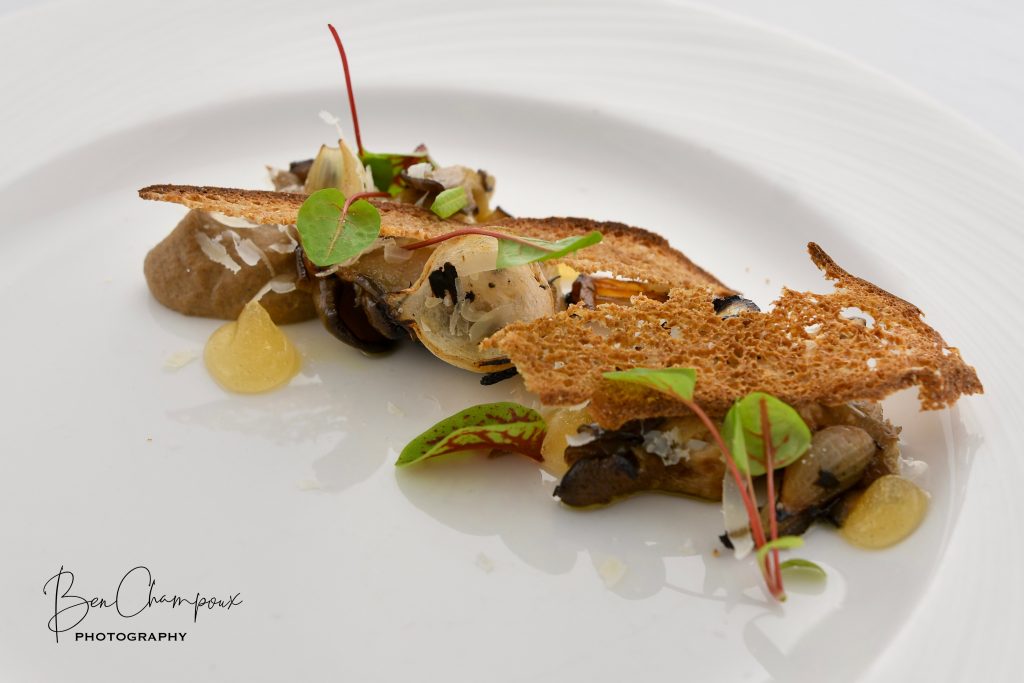 The final plate of the week came from Chef Marc-André Jetté of Hoogan & Beaufort, in Montreal. After all that had come before, his dish seemed disarmingly simple – perhaps all the more welcome for that. He had brought a miniature hibachi grill to Ottawa to replicate the open fire in his restaurant and tonight he used it to grill juicy oyster mushrooms. These he decorated with scorched petals of pickled onion and lace-like, almost transparent crisps of smoked bread. Other elements intensified the mushroomness of his vision – dots of matsutake gel, and a buttery mushroom purée perfect for eating with those toasts. To complete the dish, he grated a little Louis d’Or cheese over all and dropped a handful of red vein sorrel leaves for colour and freshness. Chef had served a beer with this dish in Montreal when he won the regional event. Tonight he poured a sturdy red wine, the 2017 Métis Rouge from Perl Morissette in Niagara, a vibrant blend of Cabernet Franc and Pinot Noir.
The final plate of the week came from Chef Marc-André Jetté of Hoogan & Beaufort, in Montreal. After all that had come before, his dish seemed disarmingly simple – perhaps all the more welcome for that. He had brought a miniature hibachi grill to Ottawa to replicate the open fire in his restaurant and tonight he used it to grill juicy oyster mushrooms. These he decorated with scorched petals of pickled onion and lace-like, almost transparent crisps of smoked bread. Other elements intensified the mushroomness of his vision – dots of matsutake gel, and a buttery mushroom purée perfect for eating with those toasts. To complete the dish, he grated a little Louis d’Or cheese over all and dropped a handful of red vein sorrel leaves for colour and freshness. Chef had served a beer with this dish in Montreal when he won the regional event. Tonight he poured a sturdy red wine, the 2017 Métis Rouge from Perl Morissette in Niagara, a vibrant blend of Cabernet Franc and Pinot Noir.
And with that, our tasting came to an end. It was time to crunch all the numbers and see how matters lay. This year, we had no runaway winner. Nor did we have any argument about who deserved to stand on the podium. Our bronze medal went to Emily Butcher of deer + almond, in Winnipeg. Our silver medal went to Marc-André Jetté of Hoogan & Beaufort, in Montreal. And the chef who won gold and became Canada’s new Culinary Champion was Roger Ma of Boulevard Kitchen and Oyster Bar in Vancouver.
Congratulations to all our regional champions who came to Ottawa and performed so magnificently! It was a triumphant weekend that none of us will ever forget.
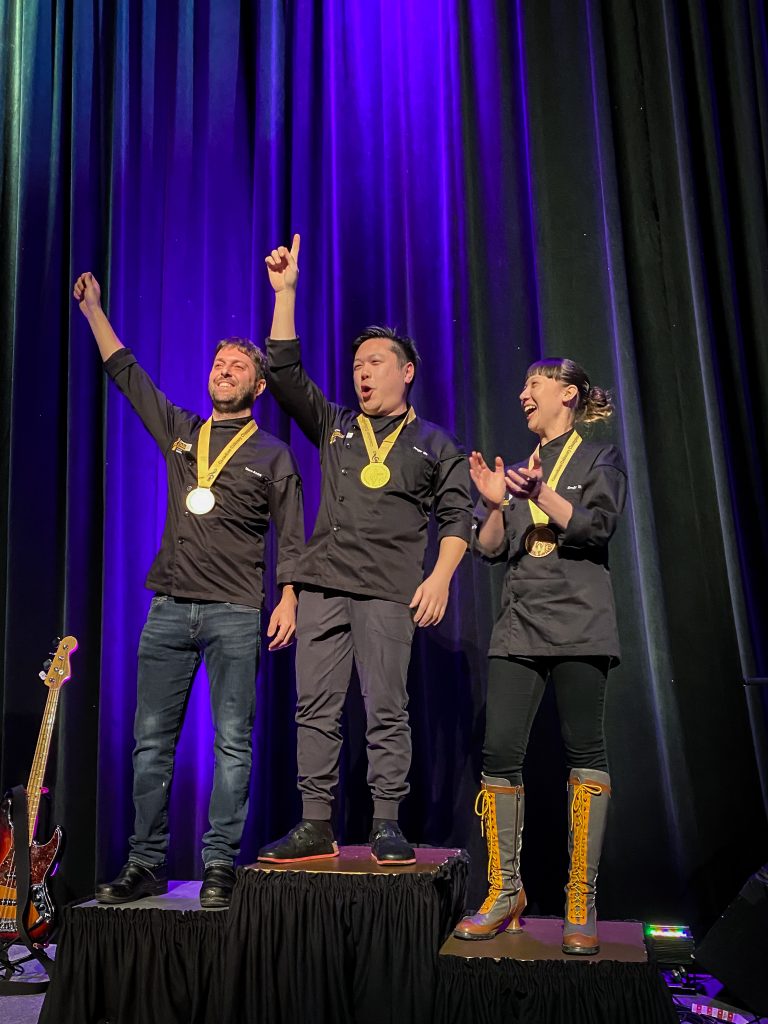
Left, silver Marc-Andre Jette; right, bronze, Emily Butcher; centre, gold, Roger Ma

